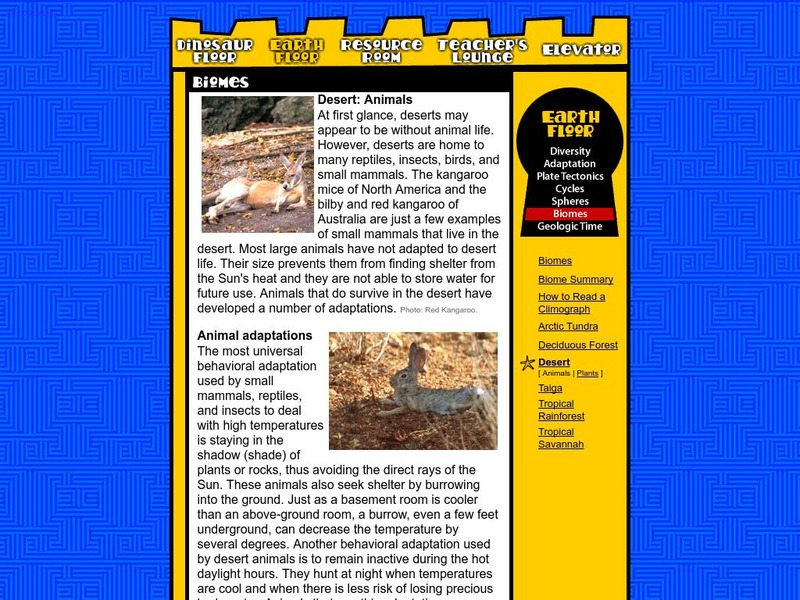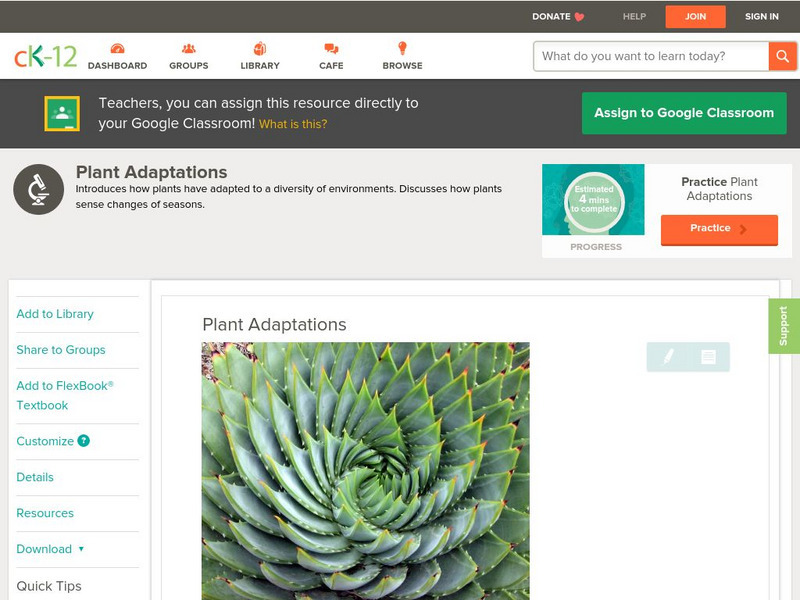Hi, what do you want to do?
Curated OER
Artificial Selection
The second lesson in the series begins with a starter activity discussing wild versus domesticated animals. Then, scholars play a card game, with optional variations, to emphasize artificial selection. Next, they attend a field trip to a...
Curated OER
Photosynthesis
We all know photosynthesis happens, but why should we care? Here is a unit that covers everything young scholars need to know about photosynthesis. Hands-on activities, assessments, and lectures guide pupils though the physiology of...
K20 LEARN
Leaning Plants: Plant Adaptations, Growth, And Tropisms
Young scientists examine pictures of plants, then explore plant reactions found on the Missouri Botanical Gardens website. Scholars investigate why plants lean, then observe a plant of their own for six weeks to make new claims,...
Chicago Botanic Garden
Meet the Naturalists
Studying plants is a full-time job—for some. After learning the ins and outs of phenology in the first three lessons in the unit, pupils explore the history of the science. The instructional activity highlights five historical...
Chicago Botanic Garden
Plant Phenology Data Analysis
Studying data over time can paint a pretty interesting picture. Learners use data they collected in the previous lesson to compare to historical data in a similar region. They graph the data of the first bloom of a specific species over...
National Wildlife Federation
Pollinator's Journey: Grades 9-12
Gain a deeper understanding of migratory pollinators. After studying about pollinators and their effects on flowering plants, learners hear a story about the migration of Monarch butterflies and bats in the Sonoma Desert. Small groups...
Nuffield Foundation
Observing Water Moving Through Plants
We know plants assist in the water cycle, but how do plants get water from the ground into the air? Through a series of demonstrations or labs, scholars observe the movement of water through plants. They microscopically view the cells...
Science Matters
Blubber Gloves: It’s All About Insulation
Instill the concept of adaptation with the help of Blubber Gloves—ziplock bags, shortening, and duct tape. Scholars discuss how animals and plants keep warm in polar regions, record their predictions, and try on their Blubber Gloves to...
NASA
The Case of the Wacky Water Cycle
Join the tree house detectives in learning about the processes of the water cycle, water conservation, water treatment, and water as a limited resource.
Curated OER
AP: Chapter 29 and 30: Plant Diversity
It's a jungle out there! That is because of the tremendous diversity among plants. In this AP biology assignment, botanists answer questions about plant evolution, diversity, and reproduction. They differentiate between monocots and...
Curated OER
Creepers and Climbers
Students compare vines. In this vines instructional activity, students analyze the adaptations common in vines. Students determine if the vine grows using tendrils, modified roots, or twining stems. Students explore a forest area to flag...
Curated OER
Adaptations
Sixth graders identify plant adaptations. In this adaptations lesson, 6th graders use digital cameras to photograph plants found on their campus. Students describe the adaptations for each plant.
Curated OER
What is a Plant?
In this plant characteristics worksheet, students will read a paragraph about plants and then use the information found in that paragraph to complete 3 short answer questions about plant adaptations.
Curated OER
Roots, Stems, and Leaves
In this plant worksheet, students review the structure and function of roots, stems, and leaves. This worksheet has 5 matching, 7 true or false, 4 multiple choice, and 10 fill in the blank questions.
Pennsylvania Department of Education
Plant and Animal Adaptations
Fourth graders identify behavioral and structural adaptations to plant and animal life. In this unit overview, 4th graders discuss the importance of variation and adaptation in a species survival. This is a unit overview and does not...
Curated OER
Adaptations of plants for seed dispersal
In this plants worksheet, students place plants in various categories depending on what special adaptations they have for scattering their seeds. There is room to record 5 different plants. They then describe how 5 fruits have adapted...
Estrella Mountain Community College
Maricopa Community College: Nonvascular Plants and Nonseed Vascular Plants
Very detailed outline describing several aspects of plant diversity, including vascular vs. nonvascular, evolutionary adaptations, homosporous and heterosporous life cycles, and specific information on some ancient species (Lycophytes,...
CK-12 Foundation
Ck 12: Episd: Plant Adaptations
[Free Registration/Login may be required to access all resource tools.] Recognize and explain how plants adapt to their environments.
Other
Rose Hills Foundation Conservatory for Biological Science
All about plants has information on plant parts--seeds, flowers, fruits, roots, and spores--and plant processes--seed dispersal, germination, pollination, and photosynthesis. You can also take a tour of this Los Angeles-based...
Center for Educational Technologies
Earth Science Explorer: Tropical Savannah Biome
Discover the tropical savannah biome! Here you can learn what a tropical savannah is, where such places exist, and the animals and plants that can be found there.
Ohio State University
Ohio State University: Anthophyta, Evolution & Diversity
An online summary of the evolution of flowering plants at an advanced level. The text is supported by good illustrations and is followed by a quiz. This is a good review for exams.
Center for Educational Technologies
Wheeling Jesuit University: Arctic Tundra Biome
Provides text and pictures on the arctic tundra, its animals, plants, and their adaptations.
Other
Fairchild Tropical Botanic Garden: What Are Adaptations [Pdf]
This pdf presents a thorough examination of plant adaptations with emphasis on different types of functional and reproductive adaptations.
CK-12 Foundation
Ck 12: Biology: Plant Adaptations
[Free Registration/Login may be required to access all resource tools.] An overview of how plants have adapated to their environments.


























